
Banksia lanata is a species of shrub that is endemic to a restricted area of Western Australia. It has linear leaves, pale cream-coloured flowers in a head with whitish bracts at the base and later up to fifty elliptical follicles in each head.
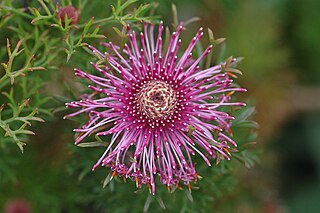
Isopogon formosus, commonly known as rose coneflower, is a species of flowering plant in the family Proteaceae and is endemic to the south-west of Western Australia. It is a shrub with divided leaves with cylindrical segments, and spherical to oval heads of pink or red flowers.
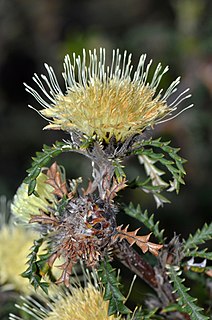
Banksia kippistiana is a species of shrub that is endemic to Western Australia. It has linear, pinnatifid leaves with ten to twenty lobes on each side, heads of up to eighty yellow and cream-coloured flowers, and elliptical follicles.

Isopogon sphaerocephalus, commonly known as drumstick isopogon or Lesueur isopogon, is a species of plant in the family Proteaceae and is endemic to the south-west of Western Australia. It is a shrub with linear to narrow egg-shaped leaves and spherical heads of hairy white to creamy yellow flowers.

Petrophile canescens, commonly known as conesticks, is a species of flowering plant in the family Proteaceae and is endemic to eastern Australia. It is an erect shrub with pinnately-divided leaves and oval heads of hairy, white to pale cream-coloured flowers.
Persoonia leucopogon is a species of flowering plant in the family Proteaceae and is endemic to Western Australia. It is an erect to low-lying shrub with branchlets that are densely hairy when young, narrow oblong to narrow elliptic leaves and yellow or greenish yellow flowers borne singly or in groups of up to four on a rachis up to 2 mm (0.079 in) long.
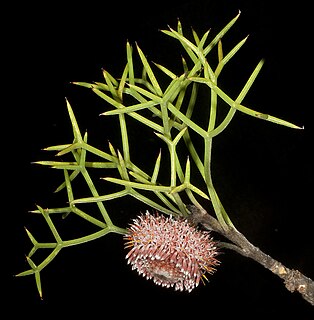
Isopogon teretifolius, commonly known as nodding coneflower, is a species of flowering plant in the family Proteaceae and is endemic to the southwest of Western Australia. It is an erect shrub with cylindrical, sometimes branched leaves, and flattened-spherical heads of hairy pinkish flowers.

Isopogon spathulatus is a species of flowering plant in the family Proteaceae and is endemic to south-western Western Australia. It is a shrub with linear to egg-shaped leaves with the narrower end towards the base, and more or less spherical heads of hairy pink flowers.
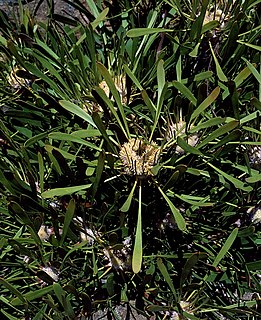
Isopogon polycephalus, commonly known as clustered coneflower, is a species of plant in the family Proteaceae and is endemic to the south coast of Western Australia. It is a spreading shrub with linear to lance-shaped leaves with the narrower end towards the base, and clusters of more or less spherical heads of white, cream-coloured or yellow flowers.

Petrophile acicularis is a species of flowering plant in the family Proteaceae and is endemic to southwestern Western Australia. It is a low, tufted shrub with cylindrical leaves and oval heads of densely hairy, cream-coloured flowers.

Petrophile aculeata is a species of flowering plant in the family Proteaceae and is endemic to southwestern Western Australia. It is a small shrub with narrow egg-shaped leaves with the narrower end towards the base and with irregular teeth near the end, and more or less spherical heads of hairy yellow flowers.

Petrophile antecedens is a species of flowering plant in the family Proteaceae and is endemic to southwestern Western Australia. It is a small, erect, open shrub with sharply-pointed, cylindrical leaves and spherical heads of hairy, pale cream-coloured flowers.

Petrophile arcuata is a species of flowering plant in the family Proteaceae and is endemic to southwestern Western Australia. It is a spreading shrub with cylindrical leaves and oval to spherical heads of hairy yellowish flowers.
Petrophile aspera is a species of flowering plant in the family Proteaceae and is endemic to southwestern Western Australia. It is a low shrub with relatively long, cylindrical leaves often curled at the tip, and oval heads of scented pale pink to pale yellow or white flowers.
Petrophile axillaris is a species of flowering plant in the family Proteaceae and is endemic to southwestern Western Australia. It is a shrub with pinnately-divided, sharply-pointed leaves, and spherical heads of hairy pink or grey flowers.

Petrophile biternata is a species of flowering plant in the family Proteaceae and is endemic to southwestern Western Australia. It is a shrub with biternate or pinnate, sharply-pointed leaves, and oval or spherical heads of glabrous, sticky, yellow flowers.

Petrophile brevifolia is a species of flowering plant in the family Proteaceae and is endemic to southwestern Western Australia. It is a shrub with cylindrical, sharply-pointed leaves, and spherical heads of hairy yellow, cream-coloured or white flowers.
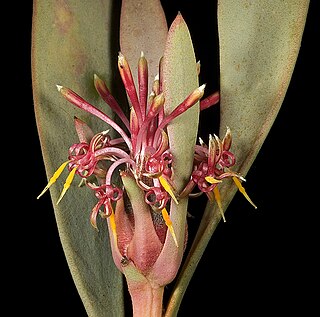
Isopogon pruinosus is a species of flowering plant in the family Proteaceae and is endemic to southwestern Western Australia. It is a compact, spreading shrub with narrow egg-shaped leaves with the narrower end towards the base and spherical to elliptic heads of pink flowers.

Isopogon inconspicuus is a plant in the family Proteaceae and is endemic to the southwest of Western Australia. It is a small shrub with pinnate leaves with cylindrical leaflets, and pink to purple flowers covered with grey hairs.
Petrophile foremanii is a species of flowering plant in the family Proteaceae and is endemic to southwestern Western Australia. It is a shrub with more or less cylindrical leaves and elliptic to spherical heads of hairy, creamy yellow flowers on the ends of branchlets.
















